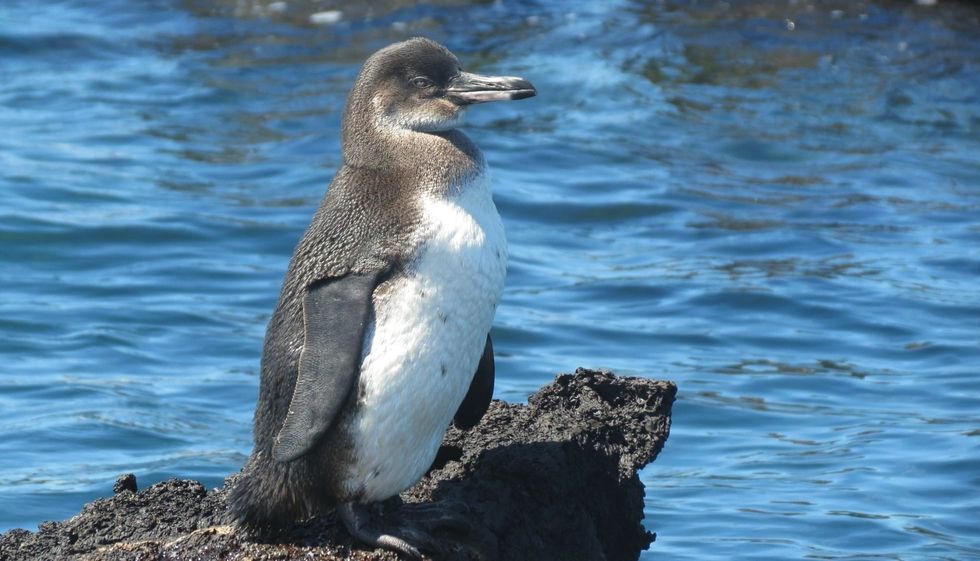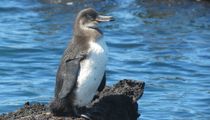Galapagos penguins (Spheniscus mendiculus) are a species of penguins found north of the equator. The population of these penguins is found on the Galapagos Islands, inlcuding Isabela Island, Floreana Island, Santiago Island, Bartolome Island, Santa Cruz Island, and Fernandina Island.
The Galapagos penguin is closely related to the Magellanic, Humboldt, and African penguins. Galapagos penguins don't go far in the water as they fear that they could be hunted by sea lions, sharks, or fur seals. They are also the prey of owls, hawks, and crabs, and someimtes snakes prey on their eggs.
There are many Galapagos penguin adaptations that allow them to survive so close to the equator. One adaptation is that they mate for life and form monogamous pairs.
The female penguin lays one or two eggs at a time and these eggs are large and white-colored. These eggs take 38-40 days to hatch and the penguins make their nests in breaks and holes of igneous rock.
They'll also often burrow a tunnel in the sand for additional security. Some of them like to add leaves, twigs, rocks, sticks, and stones to their nests too.
Learn more about these water-loving penguins here, and after reading this, do read our chinstrap penguin and gentoo penguin facts too.
Galapagos Penguin Interesting Facts
What type of animal is a Galapagos penguin?
Galapagos penguins are water-loving animals that are found on the Galapagos Islands.
What class of animal does a Galapagos penguin belong to?
This penguin species belongs to the bird class of animals, known as Aves.
How many Galapagos penguins are there in the world?
There are around 1,500 Galapagos penguins left in the world.
Where does a Galapagos penguin live?
They live in the water surrounding the Galapagos Islands.
What is a Galapagos penguin's habitat?
Galapagos Penguins live among the edges of the water, and in small rocky caves that are created by cooled lava. However, they like to spend a lot of their time in the sea. They are the only wildlife species of penguins that live on the equator.
Who do Galapagos penguins live with?
Galapagos penguins live in groups, and the name of their groups depends on their location. A group of Galapagos penguins on land is called a colony, waddle, rookery, or huddle. A group of Galapagos penguins at sea is called a raft.
How long does a Galapagos penguin live?
The Galapagos penguin's lifespan lies between 15-20 years.
How do they reproduce?
As important courtship rituals, these penguins perform adance where the penguin extends its neck upwards and spreads its wings to move them quickly to attract a mate. Galapagos penguins can mate whenever they experience favorable breeding conditions during the year.
However, their breeding season regularly arrives twice a year, between April to May and August to September. The female lays one or two eggs which are incubated for 35-40 days.
What is their conservation status?
Galapagos Penguins are classified as Endangered. Their population is less than 2000 on the Galapagos Islands.
Galapagos Penguin Fun Facts
What do Galapagos penguins look like?
This wildlife species of birds are black and white in color. Their general tone is dark, including their flippers and faces. Furthermore, they have two dark bands that stretch across their white chests. They have a white circling line that bends around their eyes.
How cute are they?
This penguin species is very cute, and these flightless birds look adorable while walking.
How do they communicate?
This penguin species is very loud when they need to speak with one another and they mainly communicate with their voice. Penguins of all species perform visual presentations too. Penguins also use their body language to speak with different penguins.
How big is a Galapagos penguin?
Galapagos penguins are the second smallest penguins found on the Galapagos Islands, their average length is 19 in (48.26 cm).
How fast can a Galapagos penguin fly?
Galapagos penguins can't fly, but they can reach a speed of 15 mph (24 kmph) while they are underwater.
How much does a Galapagos penguin weigh?
A Galapagos penguin's weight is between 5-8 lb (2.5-4.5 kg). They are less heavy than most other species of penguins.
What are their male and female names of the species?
The species name for both male and female Galapagos penguins is S. mendiculus. They do not have specific names for males and females.
What would you call a baby Galapagos penguin?
The babies of Galapagos penguins are called chicks.
What do they eat?
A Galapagos penguin (Spheniscus mendiculus) feeds on pelagic fish such as sardines, anchovies, and mullets.
Are they dangerous?
No, this species of penguins are not dangerous to people, but they can become aggressive to their partners and predators, depending on the circumstance and need.
Would they make a good pet?
They cannot be kept as a pet, as the only suitable habitat for this wildlife species is the Galapagos Islands. Most of the penguin population of this species is seen on Isabela and Fernandina Islands, situated in the western part of the archipelago.
You can adopt a Galapagos penguin (Spheniscus mendiculus) from the Galapagos Conservation Trust and this allows you to contribute to the conservation of Galapagos penguins, Galapagos giant tortoises, Galapagos sea lions, hammerhead sharks, and Floreana mockingbirds.
Did you know...
One of the best Galapagos penguin facts for kids is that they are social birds, and they like people to move towards them. However, you should not get closer than 118 in (3 m) in distance to these penguins.
This species is not found in any zoo in the whole world!
These penguins are important because they are an important food source to many animals in the ecosystem.
What is unique about the Galapagos penguin?
One of the main differences between Galapagos penguins and other penguins is that they can swim in tropical waters, playing an important role in their ecosystem's balance. Another unique factor is that they have a C-shaped stripe of feathers from their eyes to their chin on both sides of their face.
They also have very unique adaptations to their tropical climate. They pant heavily and also lean forward to protect their feet from the sun, which helps them keep cool.
Why are Galapagos penguins endangered?
Galapagos penguins are endangered due to restricted habitats and food sources available on the Galapagos islands. Climate change has also had a large impact on these birds' survival.
Natural and man-made disasters, including volcanic eruptions and oil slicks, have caused drastic losses in their population. According to research, it has been estimated that there are less than 600 breeding pairs of Galapagos penguins alive today.
In order to help increase their population, they have been provided with nesting sites made of lava rocks for breeding and to help keep their nests, eggs, and chicks safe and cool. The penguin population has also been provided with a sufficient food supply by conservationists.
Here at Kidadl, we have carefully created lots of interesting family-friendly animal facts for everyone to discover! Learn more about some other birds, including the brant or the great tit.
You can even occupy yourself at home by drawing one on our Galapagos penguin coloring pages.










